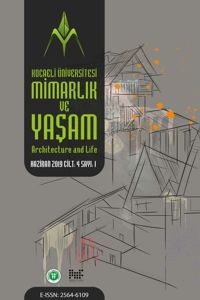Öz
Mimarlık eğitimi, bilimsel araştırmalar için
oldukça zengin bir alan olmasına rağmen Mimarlık Teknolojisi eğitimi ile ilgili
çalışmalara çok rastlanılamamaktadır. Özellikle Türkiye'deki mimarlık okulları
göz önüne alındığında, Mimarlık Teknolojisi eğitimi ile ilgili farklı
yaklaşımların sayısının, üniversitelerde artan sayıda farklı mimari eğitim
programlarına paralel olduğunu söylemek yanlış olmaz. Bu karmaşayı netleştirmek
amacıyla yapılan bu çalışma ile Türkiye'de Mimarlık Teknolojisi eğitimi ile
ilgili farklı yaklaşımlar hakkında bir araştırma yapmak ve mevcut türleri ve
eğilimleri ortaya koymak hedeflenmiştir. Mimari Teknoloji eğitimindeki farklı
yaklaşımları göstermek için otuz mimarlık fakültesi seçilmiş ve genel
yönelimleri yansıtmak üzere analiz edilmiştir. Üniversitelerin seçimleri
ÖSYM’nin “Merkezi Yerleştirme İle Öğrenci Alan Yükseköğretim Lisans
Programları” listesindeki taban puan sıralamasına göre yapılmıştır. Araştırma
verileri, okulların resmi web sitelerindeki “Akademik Paket” sekmelerinde ilan
edilen eğitim programlarından elde edilmiş ve niceliksel bir analiz
yapılmıştır. Bu analiz sürecinin sonucunda Mimari Teknoloji eğitimini oluşturan
alt-alanların (Yapı Malzemeleri, Mimarlıkta Yapı ve Yapım Teknolojileri, Yapı
Fiziği, Taşıyıcı Sistemler vb.) AKTS değerleri, ders sayıları, haftalık ders
saatleri ve yer aldıkları eğitim-öğretim dönemlerine yönelik olarak bir
değerlendirme ve karşılaştırma yapmak mümkün olmuştur.
Anahtar Kelimeler
Mimari Teknoloji Eğitimi Yapı Teknolojisi Eğitimi Mimarlık Eğitimi
Kaynakça
- Boge, Patricia., and Sullivan, Jim (2004). “Curricular Weaving”, 92nd ACSA Annual Meeting, School of Architecture and Community Design, University of South Florida, 2004, pp. 496-500.
- D’Souza, Newton. “Design intelligences: A case for multiple intelligences in architectural design”, International Journal of Architectural Research: ArchNet-IJAR, 1(2), 2007, pp. 15-34.
- Emmitt, Stephen, Architectural Technology, Blackwell Science Ltd., 2002
- Ghonim, Mohammed, and Nehad Eweda. "Investigating elective courses in architectural education." Frontiers of architectural research 7.2 (2018): 235-256.
- Oakley, Deborah and Ryan E. Smith. “Building Technology Educators' Symposium.” Bridging the Gap: Reviving Pedagogic Discourse in Architectural Technology Education, 2007, pp. 583–590.
- Ozmehmet, Ecehan, and Ebru Alakavuk. "Integration process of theoretical courses with design studios in undergraduate education: Case studies of architecture and interior design studios." SHS Web of Conferences. Vol. 26. EDP Sciences, 2016.
- Pultar, Mustafa. "Building Education: From Fragmentation to Integration." Engineering Education in the Third Millennium: Referate des 28. Internationalen Symposiums" Ingenieur Pedagogik. Vol. 99. 1999.
- URL-1: http://www.osym.gov.tr/TR,12735/2016-osys-yuksekogretim-programlarinin-merkezi-yerlestirmedeki-en-kucuk-ve-en-buyuk-puanlari-kitabi.html (Erişim tarihi: 12.09.2018, saat: 11.10)
- URL-2: http://www.uak.gov.tr/temelalan/2018N_BilimAlanlariAnahtarKelimeler_071217.pdf (Erişim tarihi: 09.10.2018, saat: 13.50)
- URL-3: http://www.mo.org.tr/miak/belge/dsp-Akreditasyonkosul.pdf (Erişim tarihi: 09.10.2018, saat: 14.40)
Öz
Architectural education is a generous field for
researches; however, the studies about Architecture Technology education are
very limited. Especially when the architecture schools in Turkey are
considered, it is safe to say that the number of different approaches about the
Architectural Technology education is parallel with the increasing number of
different architectural education programs in universities. To clarify this
tangled picture, this study intends to make a research regarding different
approaches about Architectural Technology education in Turkey and to put
forward the current types and trends. In order to demonstrate different
approaches in Architectural Technology education, thirty architecture schools
have been chosen and analyzed to reflect the main picture. The selection has
been carried out according to the OSYM ’s list of undergraduate programs. The
research material has been obtained from the schools’ education programs
declared in their web sites as “Academic Package” and the analysis has been
made by the quantitative factors. As a result of these analysis process, it is
possible to evaluate and compare the sub-fields of the Architectural Technology
education (Building Materials, Building Construction, Building Physics,
Structures etc.) according to the ECTS values, number of the courses, weekly
course hours, and semesters.
Anahtar Kelimeler
Architectural Technology Education Construction Technology Education Architectural Education
Kaynakça
- Boge, Patricia., and Sullivan, Jim (2004). “Curricular Weaving”, 92nd ACSA Annual Meeting, School of Architecture and Community Design, University of South Florida, 2004, pp. 496-500.
- D’Souza, Newton. “Design intelligences: A case for multiple intelligences in architectural design”, International Journal of Architectural Research: ArchNet-IJAR, 1(2), 2007, pp. 15-34.
- Emmitt, Stephen, Architectural Technology, Blackwell Science Ltd., 2002
- Ghonim, Mohammed, and Nehad Eweda. "Investigating elective courses in architectural education." Frontiers of architectural research 7.2 (2018): 235-256.
- Oakley, Deborah and Ryan E. Smith. “Building Technology Educators' Symposium.” Bridging the Gap: Reviving Pedagogic Discourse in Architectural Technology Education, 2007, pp. 583–590.
- Ozmehmet, Ecehan, and Ebru Alakavuk. "Integration process of theoretical courses with design studios in undergraduate education: Case studies of architecture and interior design studios." SHS Web of Conferences. Vol. 26. EDP Sciences, 2016.
- Pultar, Mustafa. "Building Education: From Fragmentation to Integration." Engineering Education in the Third Millennium: Referate des 28. Internationalen Symposiums" Ingenieur Pedagogik. Vol. 99. 1999.
- URL-1: http://www.osym.gov.tr/TR,12735/2016-osys-yuksekogretim-programlarinin-merkezi-yerlestirmedeki-en-kucuk-ve-en-buyuk-puanlari-kitabi.html (Erişim tarihi: 12.09.2018, saat: 11.10)
- URL-2: http://www.uak.gov.tr/temelalan/2018N_BilimAlanlariAnahtarKelimeler_071217.pdf (Erişim tarihi: 09.10.2018, saat: 13.50)
- URL-3: http://www.mo.org.tr/miak/belge/dsp-Akreditasyonkosul.pdf (Erişim tarihi: 09.10.2018, saat: 14.40)
Ayrıntılar
| Birincil Dil | İngilizce |
|---|---|
| Konular | Mimarlık |
| Bölüm | Makaleler |
| Yazarlar | |
| Yayımlanma Tarihi | 30 Haziran 2019 |
| Yayımlandığı Sayı | Yıl 2019 Cilt: 4 Sayı: 1 |


